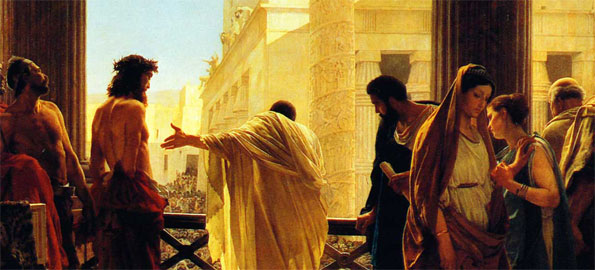
Antonio Ciseri’s depiction of Pontius Pilate presenting a scourged Christ to the people (painted 1871).
According to reports in the Gospels, Temple Guards responded to indications of positive identity of an offender named Jesus by his disciple Judas Iscariot, and arrested Jesus in the Garden of Gethsemane Friday. Judas was rewarded 30 pieces of silver (Matthew 26:14–16) for betraying and identifying Jesus. Judas Iscariot previously told authorities that whomever he kisses is the one to arrest. Following his arrest, Jesus was brought to the house of Annas, the father-in-law of the high priest, Caiaphas. Jesus was interrogated with little result and sent secured and bound to Caiaphas the high priest where the Sanhedrin had assembled (John 18:1–24).
Conflicting testimony against Jesus was brought forth by many witnesses. Jesus responded only with silence. Finally the high priest adjured Jesus to testify under solemn oath, saying “I adjure you, by the Living God, to tell us, are you the Anointed One, the Son of God?” Jesus responded ambiguously saying, “You have said it, and in time you will see the Son of Man seated at the right hand of the Almighty, coming on the clouds of Heaven.” The high priest condemned Jesus for blasphemy, and the Sanhedrin concurred with a sentence of death (Matthew 26:57–66). Peter, waiting in the courtyard, also denied Jesus three times to bystanders while the interrogations were proceeding just as Jesus had predicted.
In the morning, the whole assembly brought Jesus to the Roman governor Pontius Pilate (fifth prefect of the Roman province of Judaea) under charges of subverting the nation, opposing taxes to Caesar, and making himself a king (Luke 23:1–2). Pilate authorized the Jewish leaders to judge Jesus according to their own law and execute sentencing. The Jewish leaders replied that they were not allowed by the Romans to carry out a sentence of death (John 18:31).
Pilate interrogated Jesus and told the assembly that there was no basis for sentencing. Upon learning that Jesus was from Galilee, Pilate was concerned about jurisdiction and referred the case to the ruler of Galilee, King Herod. Herod, who was in Jerusalem for the Passover Feast questioned Jesus but received no answer. Herod sent Jesus back to Pilate. Pilate told the assembly that neither he nor Herod found Jesus guilty.
Pilate resolved to have Jesus whipped and released (Luke 23:3–16). Under the guidance of the chief priests, the crowd asked for Barabbas, who had been imprisoned for committing murder during an insurrection. Pilate asked what they would have him do with Jesus, and they demanded, “Crucify him” (Mark 15:6–14). Pilate’s wife had seen Jesus in a dream earlier that day, and she forewarned Pilate to “have nothing to do with this righteous man” (Matthew 27:19). Pilate had Jesus flogged and then brought him out to the crowd to release him. The chief priests informed Pilate of a new charge, demanding Jesus be sentenced to death “because he claimed to be God’s son.” This possibility filled Pilate with fear, and he brought Jesus back inside the palace and demanded to know from where he came (John 19:1–9).
Presenting before the crowd for the final time, Pilate declared Jesus innocent and washed his own hands in water to show he has no part in this condemnation. However, Pilate did not protect Jesus, and released him to be crucified in order to forestall a riot (Matthew 27:24–26) and ultimately to keep his position. The sentence written was “Jesus of Nazareth, King of the Jews.” Assisted by Simon of Cyrene, Jesus carried his cross to the site of execution, known as the place of the Skull or “Golgotha” in Hebrew or “Calvary” in Latin. At the place of the Skull, Jesus was crucified along with two criminals (John 19:17–22).
Jesus suffered on the cross for six hours. During his last three hours on the cross, from noon to 3 pm, the sky darkened. Jesus gave up his spirit while crying loudly, “My God, my God, why have you forsaken me?” Simultaneously an earthquake struck, tombs broke open, and the curtain in the Temple was torn from top to bottom. The centurion on guard at the site of crucifixion declared, “Truly this was God’s Son!” (Matthew 27:45–54)
Good Friday is not a government holiday at the federal level in the United States.
Good Friday is a state holiday in …
Connecticut,
Delaware,
Florida,
Hawaii,
Indiana,
Kentucky,
Louisiana,
New Jersey,
North Carolina,
North Dakota,
Tennessee and
Texas


 Amazon Best Sellers in Audible Books
Amazon Best Sellers in Audible Books